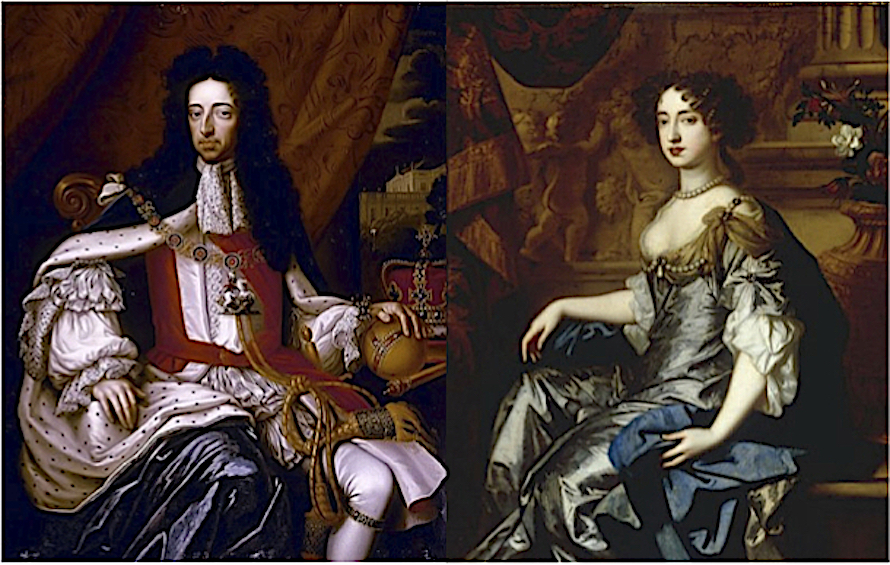
Welcome to the first of a series of exciting new blog posts, where we look at some of the distinct ages within the world of antique furniture. We will be looking at the wider context in which the furniture of each epoch was made; and how these trends influenced furniture design.
The names of early British movements in antique furniture design, are largely attributed to the reigns of kings and queens.
The move away from this trend, to a degree, mirrors the shift in power and influence away from the monarchy, to parliamentary politics, democracy and constitutional monarchy.
William and Mary’s reign was not long, but it had a strong and lasting influence upon furniture design fashion and development.
A unique selection of antique furniture for sale.
William and Mary’s reign occurred towards the end of the Stuart era.
The Stuarts were the first Kings and Queens of the United Kingdom. They ruled from 1603 until 1714.
In 1603 King James VI of Scotland, became King James I of England, combining the two thrones, thus styling himself as the ‘King of Great Britain.’
The Stuart era was an interesting one. A strong court culture emerged in this era, and with that came a refinement in the design and production of fine furniture.
The era was also defined by war, plague, revolution and burgeoning radical politics. And of course Oliver Cromwell’s short lived republic, the only one we have known in the history of the United Kingdom.
William and Mary’s reign came not long after by the restoration of the British monarchy. Mary was the first daughter of James II, the second, Queen Ann, proceeded William and Mary on the throne after their deaths.
Pictured here as a child with her mother, sister and father James II, Mary a protestant, deposed her Catholic father, bringing greater stability to the isles.
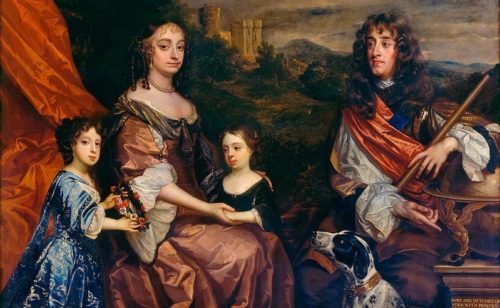
Husband and wife William and Mary, ruled the United Kingdom from 1689 until 1702. Both had a claim to the British throne, and their alliance was a tactical one.
As a devout protestant, Dutch Prince, William of Orange, was invited to marry his first cousin Mary, who held a more direct link to the throne. Thus preventing the advent of a Catholic dynasty on the sudden and dubious appearance of a Catholic male heir to James II.
There is said to have been little in the way of true romantic love between the couple, but there appears to have been a respect based on one another’s religious faith and moral code.
Their ascendance to power is known as the ‘Glorious Revolution’. They deposed James II, in a relatively amicable and peaceful revolution, bringing stability to the political climate of the day.
Their alliance bolstering positive relations with Scotland initially, and appeased the predominantly Protestant English population.
The aesthetic sensibilities of William of Orange were highly influential and upon the furniture design of the day.
William’s Dutch taste was widely embraced, and had a strong influence upon lates 17th century furniture design and beyond. He brought with him a lighter, more refined feel.
During the Stuart era so far there had been a slight transition away from the bulkier medieval oak style, and an increasing refinement. This was greatly accelerated during this time.
Furniture became more comfortable. Chair legs became splayed, making them less likely to tip over.
Upholstery and padding for chairs really came in during this era, as did the curving of back splats to better fit the shape of the spine. You might say it was the birth of true ergonomic awareness in furniture design. Along with an acknowledgment that furniture could be more function and comfortable.
One of the most significant features that emerged in this period was the use of the cabriole leg in furniture design. This allowed for the removal of the stretchers, or a refinement in stretcher design. Cabriole legs also allowed furniture to become longer and more elegant.
Less bulkiness in stretchers, or their removal, allowed for great comfort, and had a strong influence upon how furniture design evolved going forward.
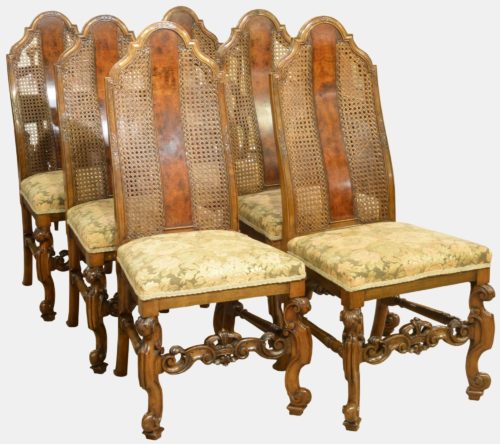
It was in this period that marquetry was introduced into British fine cabinet making. And furniture became graceful and decorative.
The Baroque art and design era was also just reaching Britain at the time, and also began to influence the design of this era.
The style was a complete rejection of the heavy and blocky English furniture of the past, often associated with earlier values, James II, and papism. This was an era where design became a little lighter, curvier and freer.
William and Mary furniture is associated with being slender, taller and lighter in appearance, made possible, in part, by the creation of dovetailing, as well as the cabriole leg.
Dutch furniture was not only lighter and smoother, but also more versatile. Perhaps in part because of an earlier development of a booming middle class there, that could afford to commission finer cabinet makers. Resulting in a strong furniture industry in the Netherlands at the time.
William not only brought a Dutch aesthetic with him, but actual Dutch furniture makers.
The English embraced this Dutch sensibility. Not only had William helped to cement Protestantism and stability, but his preferred aesthetic dovetailed well with the early Baroque that was beginning to emerge in the regal and ornate arts of the day, and in architecture.
William and Mary design is even sometimes referred to as early Baroque. But is better viewed as a mixture of English Baroque and Dutch influenced design. And as a period when key design innovations took place.

Some even cite oriental influence in the emergence of lacquer work and cabriole legs, with Spanish feet. Caned seats on chairs also became popular, and chinoiserie began to emerge.
Walnut was very much favoured as a wood during the William and Mary period, and some more unusual woods such as Ebonya were starting to be used for veneer work.
Mahogany was only just beginning to make its way into parlance, again an innovation of the era.
This period also marked the beginning of the waning fashion for Oak, as the Dutch, French, and European influenced cabinet makers of London, and the bigger cities, began to favour more exotic woods.
The style of furniture, note-ably and irrevocably, changed during the reign of William and Mary. The Dutch aesthetic left a lasting influence upon English cabinet making; replacing the darker, thicker and heavier medieval style.
And the innovations of marquetry, cabriole legs, dovetailing and a greater desire for furniture to be softer and more comfortable, changed the art of furniture design and creation forever.
A unique selection of antique furniture for sale.
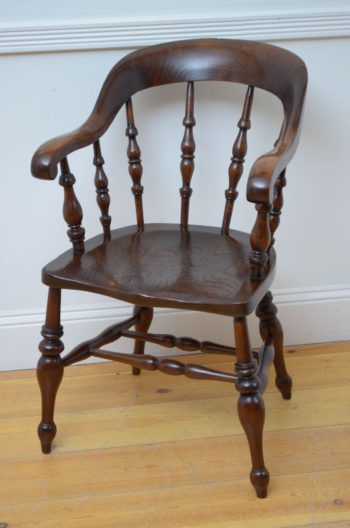 Late Victorian Elm Office or Desk Chair
£925.00
Late Victorian Elm Office or Desk Chair
£925.00
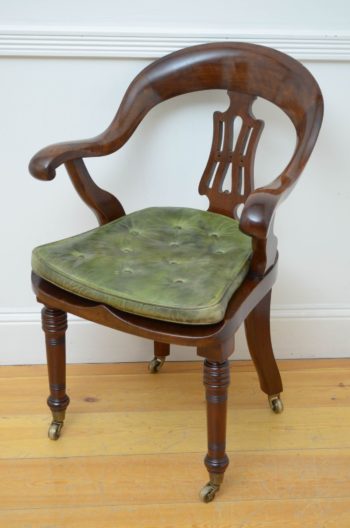 Victorian Office Chair / Desk Chair
£1,350.00
Victorian Office Chair / Desk Chair
£1,350.00
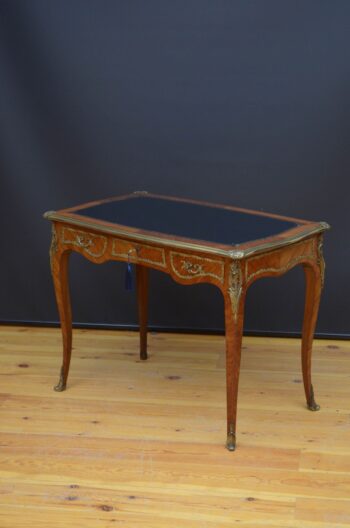 Outstanding Antique Tulipwood Writing Table
£3,250.00
Outstanding Antique Tulipwood Writing Table
£3,250.00
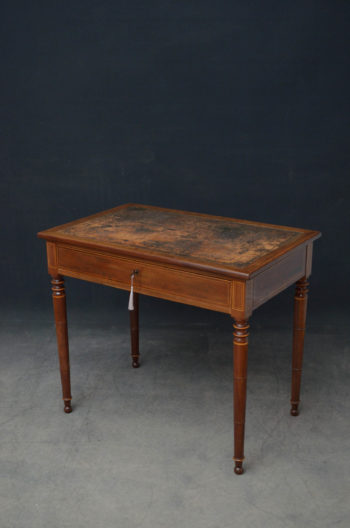 19th Century Mahogany Writing or Side Table
£1,685.00
19th Century Mahogany Writing or Side Table
£1,685.00
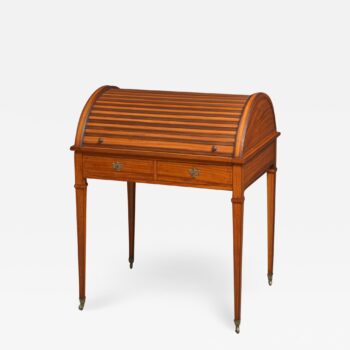 Superb Sheraton Revival Satinwood Desk
£2,950.00
Superb Sheraton Revival Satinwood Desk
£2,950.00
| Cookie | Duration | Description |
|---|---|---|
| cookielawinfo-checbox-analytics | 11 months | This cookie is set by GDPR Cookie Consent plugin. The cookie is used to store the user consent for the cookies in the category "Analytics". |
| cookielawinfo-checbox-functional | 11 months | The cookie is set by GDPR cookie consent to record the user consent for the cookies in the category "Functional". |
| cookielawinfo-checbox-others | 11 months | This cookie is set by GDPR Cookie Consent plugin. The cookie is used to store the user consent for the cookies in the category "Other. |
| cookielawinfo-checkbox-necessary | 11 months | This cookie is set by GDPR Cookie Consent plugin. The cookies is used to store the user consent for the cookies in the category "Necessary". |
| cookielawinfo-checkbox-performance | 11 months | This cookie is set by GDPR Cookie Consent plugin. The cookie is used to store the user consent for the cookies in the category "Performance". |
| viewed_cookie_policy | 11 months | The cookie is set by the GDPR Cookie Consent plugin and is used to store whether or not user has consented to the use of cookies. It does not store any personal data. |